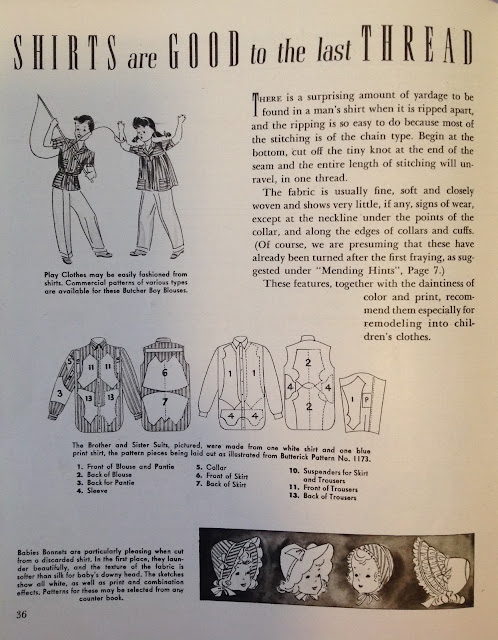During World War II rationing meant ladies were unable to purchase new clothes to keep up with style changes or children's growing bodies. Instead of passing worn clothing to younger children this booklet showed women how to alter and refit clothes.
It first showed instructions for darning, patching, and mending using the Singer sewing machine.
Restoring sweaters showed how to restore a garment's shape, alter it, and repair holes. Cutting off arms and altering the neck for a V-neck opening could turn a small sweater into a stylish vest. Appliqueing floral motifs over holes and bands of fabric to make stripes also could cover mars.
Blouses could be altered into dickeys. Torn sleeves could be replaced with new.
Below you can see how a dress was altered for bitter fit and to offer higher style.
A dress that had shrunk could be remade into a jumper or coat dress with inserts, reversing the dress, altering the neckline and sleeves, or adding back center panels.
Little girls who insist on growing taller were problem children. The suggestion was inserting bands of fabric in the skirt and even in the midriff of the dress.
Combining two dresses to make two new ones sounded too complicated for me! But converting a coat sounded easier. Here they show an old coat with a new lining, padded shoulders, reversed inserted panels in the front, color, and cuffs.
A man's shirt could make TWO shirts for the kids.
I have read that used clothing is a real trash problem. We toss away more clothing than can be used for charity, and recycling it is a problem since most fabrics in clothing manufacturing today consist of man-made fiber. Microfiber is especially a concern, with particles appearing throughout the environment.
It is suggested that we use clothes longer, buy natural fibers of wool or silk or linen, and 100% cotton where we can find it.
Or, we can learn from our foremothers and make-over clothes for longer use!






No comments:
Post a Comment